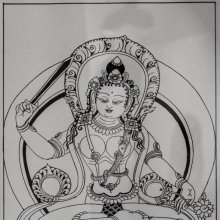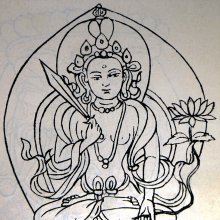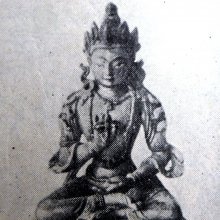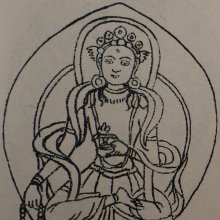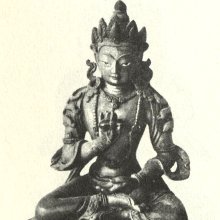Akshayamati, Akṣayamati, Akshaya-mati: 10 definitions
Introduction:
Akshayamati means something in Buddhism, Pali, Hinduism, Sanskrit. If you want to know the exact meaning, history, etymology or English translation of this term then check out the descriptions on this page. Add your comment or reference to a book if you want to contribute to this summary article.
The Sanskrit term Akṣayamati can be transliterated into English as Aksayamati or Akshayamati, using the IAST transliteration scheme (?).
Images (photo gallery)
(+1 more images available)
In Buddhism
Tibetan Buddhism (Vajrayana or tantric Buddhism)
Source: Wisdom Library: MañjuśrīnāmasaṃgītiAkṣayamati (अक्षयमति) is one of the sixteen bodhisattvas appearing in the Vajradhātu-mahāmaṇḍala, according to the Nāmamantrārthāvalokinī v5.38-41. The Nāmamantrārthāvalokinī (literally, ‘an explanation of the nāma-mantras’) is a commentary (ṭīkā) on the 8th century Mañjuśrīnāmasaṃgīti.
Akṣayamati is a name of Mañjuśrī (the embodiement of non-dual knowledge) and, together with other names, forms the core essence of the Mañjuśrīnāmasaṃgīti. The Nāmamantrārthāvalokinī provides the practitioner a sādhana (‘meditative practice’) to turn these names into mantras. These mantras are chanted for the benefit of all beings, and then placed and contemplated in the Vajradhātu-mahāmaṇḍala, which is an extended version of the Vajradhātu-maṇḍala.
Source: Wisdom Library: Tibetan BuddhismAkṣayamati (अक्षयमति) is the name of a Rākṣasa mentioned as attending the teachings in the 6th century Mañjuśrīmūlakalpa: one of the largest Kriyā Tantras devoted to Mañjuśrī (the Bodhisattva of wisdom) representing an encyclopedia of knowledge primarily concerned with ritualistic elements in Buddhism. The teachings in this text originate from Mañjuśrī and were taught to and by Buddha Śākyamuni in the presence of a large audience (including Akṣayamati).
Source: archive.org: The Indian Buddhist Iconography1) Akṣayamati (अक्षयमति) (“indestructible mind”) is the name of a Bodhisattva commonly depicted in Buddhist Iconography, and mentioned in the 11th-century Niṣpannayogāvalī of Mahāpaṇḍita Abhayākara.—His color is yellow; his symbol is the sword or jar.—The second Bodhisattva is Akṣayamati and his name is widely known in the Buddhist ritualistic literature.
Akṣayamati is described in the Niṣpannayogāvalī.—
(1: Mañjuvajra-maṇḍala):—“Akṣyamati is of golden complexion, and shows the clenched left hand against the chest, and exhibits the Varada-mudrā in the right”. (2: Dharmadhātuvāgīśvara-maṇḍala):—“Akṣyamati is yellow in colour and flourishes the sword inthe right hand, while he exhibits in the left hand the Abhayamudrā and the Kamala.” (3: Durgatipariśodhana-maṇḍala):—“Akṣyamati is white in colour and with his two hands holds the bowl containing the nectar of knowledge”.
2) Akṣayamati (अक्षयमति) or Akṣayamatilokeśvara refers to number 51 of the 108 forms of Avalokiteśvara found in the Machhandar Vahal (Kathmanu, Nepal). [Machhandar or Machandar is another name for for Matsyendra.].
Accordingly,—
“Akṣayamati also is [Avalokita Lokeśvara], except that he holds the rosary in his right hand and the lotus on a water-vessel against the chest with his left.—Avalokita Lokeśvara also is one-faced and two-armed and sits in the same attitude on a lotus. He wields the sword in his right hand and holds the stem of a lotus against the chest with his left”.
The names of the 108 deities [viz., Akṣayamati] possbily originate from a Tantra included in the Kagyur which is named “the 108 names of Avalokiteshvara”, however it is not yet certain that this is the source for the Nepali descriptions.Source: Brill: Śaivism and the Tantric Traditions (tantric Buddhism)
Akṣayamati (अक्षयमति) refers to one of the sixteen Bhadrakalpa Bodhisattvas, according to the Niṣpannayogāvalī 44ff and Abhayākaragupta’s Durgatipariśodhana-maṇḍala (Cf. Niṣpannayogāvalī 66ff.).—A set of sixteen Bodhisattvas often supplements the deities of the Tattvasaṃgraha in later Vajradhātu-maṇḍala descriptions. These are generally the sixteen Bodhisattvas of the present aeon (bhadrakalpa) [e.g., Akṣayamati], as described for example in Abhayākaragupta’s Niṣpannayogāvalī Vajradhātu-maṇḍala.—Cf. also Nāmamantrārthāvalokinī and Abhayākaragupta’s forty-three deity Mañjuvajra-maṇḍala (Tricatvāriṃśadātmakamañjuvajra-maṇḍala: see Niṣpannayogāvalī 50)

Tibetan Buddhism includes schools such as Nyingma, Kadampa, Kagyu and Gelug. Their primary canon of literature is divided in two broad categories: The Kangyur, which consists of Buddha’s words, and the Tengyur, which includes commentaries from various sources. Esotericism and tantra techniques (vajrayāna) are collected indepently.
Languages of India and abroad
Sanskrit dictionary
Source: DDSA: The practical Sanskrit-English dictionaryAkṣayamati (अक्षयमति).—name of a Buddhist.
Derivable forms: akṣayamatiḥ (अक्षयमतिः).
Akṣayamati is a Sanskrit compound consisting of the terms akṣaya and mati (मति).
Source: Cologne Digital Sanskrit Dictionaries: Edgerton Buddhist Hybrid Sanskrit DictionaryAkṣayamati (अक्षयमति).—name of a Bodhisattva: Saddharmapuṇḍarīka 3.8; 438.2 ff.; Mahāvyutpatti 702; Rāṣṭrapālaparipṛcchā 2.1; (Ārya-)Mañjuśrīmūlakalpa 311.14; 312.5; 461.6.
Source: Cologne Digital Sanskrit Dictionaries: Monier-Williams Sanskrit-English DictionaryAkṣayamati (अक्षयमति):—[=a-kṣaya-mati] [from a-kṣaya] m. Name of a Buddhist.
Source: Cologne Digital Sanskrit Dictionaries: Goldstücker Sanskrit-English DictionaryAkṣayamati (अक्षयमति):—[bahuvrihi compound] m.
(-tiḥ) The name of a Bodhisattva. E. akṣaya and mati.
[Sanskrit to German]
Sanskrit, also spelled संस्कृतम् (saṃskṛtam), is an ancient language of India commonly seen as the grandmother of the Indo-European language family (even English!). Closely allied with Prakrit and Pali, Sanskrit is more exhaustive in both grammar and terms and has the most extensive collection of literature in the world, greatly surpassing its sister-languages Greek and Latin.
See also (Relevant definitions)
Partial matches: Akshaya, Mati.
Starts with: Akshayamatilokeshvara, Akshayamatinirdesha, Akshayamatiparipriccha, Akshayamatipariprichchha, Akshayamatisutra.
Full-text: Citradhvaja, Matsarya, Matsaryasattva, Cittasamtana, Anantamatsarya, Ashayashuddhi, Ashayakshayata, Dharmaprahana, Ashayakshaya, Akshayamatilokeshvara, Vinaya, Bodhisattva, Avalokiteshvara.
Relevant text
Search found 13 books and stories containing Akshayamati, Akṣayamati, Akshaya-mati, Aksayamati, Akṣaya-mati, Aksaya-mati; (plurals include: Akshayamatis, Akṣayamatis, matis, Aksayamatis). You can also click to the full overview containing English textual excerpts. Below are direct links for the most relevant articles:
The Indian Buddhist Iconography (by Benoytosh Bhattachacharyya)
Maha Prajnaparamita Sastra (by Gelongma Karma Migme Chödrön)
Appendix 3 - Why the Bodhisattva Avalokiteśvara is so named < [Chapter LII - Elimination of the Triple Poison]
The Ratnakūṭa-sūtra < [Part 3 - Outshining the knowledge of all the Śrāvakas and Pratyekabuddhas]
Bodhisattvacharyavatara (by Andreas Kretschmar)
Bibliography Of Sūtras, Tantras And śāstras
Translator’s Introduction < [Introduction Text]
Vimalakirti Nirdesa Sutra (by Robert A. F. Thurman)
